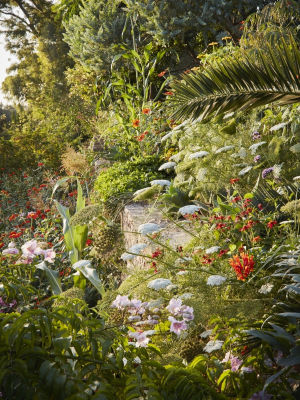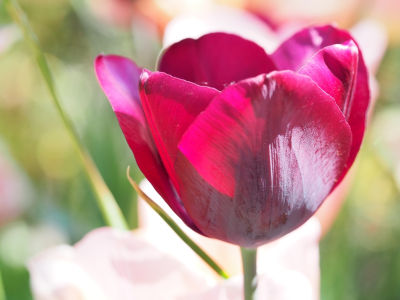

Design - Reds in the Beds! - July 2025
The harsh light of high summer here in Umbria makes it logical to want strong colours in the garden – pale shaeds will just get burned out. But we have already talked about – and disagreed over - Yellow. So what about Red?
Watching the Zoom talk by Umberto Pasti last month where he introduced us to his garden of Rohuna near Tangier, Morocco. Part of the garden he has created in the ‘cottage style’ but using strong colours. He sounded almost apologetic about it. But why?

Rohuna garden in Marocco (Photo: Umberto Pasti)
It makes sense to use plants with strong coloured flowers – red in fact. So that’s what we all do. Don’t we?
As I look out across my summer-parched garden today, all I see (apart from dust and dried brown foliage) is …. yellow (Blupleurum fruticosum doing the hard work here). And some blue (thank heavens for Perovskia). Alongside the terrace there are Oleanders looking splendid thanks to ample spring rains, but these are all paler shades of pink and cream. There are of course lots of bright red Geraniums in terracotta pots, arranged up the outdoor staircase and around the balconies, but I rather consider that to be ‘interior decorating’ rather than actual gardening.
Surely there are some red flowers in the garden - or am I missing something?
Early in spring we plant bulbs and the bulb industry has developed a massive range of tulip flower shapes and sizes - and of course colours. If we want red, then there are lots of tulips to choose from. But no other spring bulbs as far as I can recall.

Tulipa ‘Ronaldo’ in a pot
I
am hard-pressed to think of any wild flowers in the area which have truly red flowers. The wild Anemone coronaria has a pale pink-mauve flower; it is in cultivation that it has been refined to give the brilliant colours – including red ‘Hollandia’ variety – that light up the grassy paths in April.
But poppies are red, surely? Well I had thought so but looking back at my photos, the wild poppy (Papaver rhoeas) we find around here is really a shade of orange.
In the olive groves in spring there are wild Centranthus ruber - the clue to the colour being in the name (red valerian). Are these a proper red? Perhaps, but rather a dull one. Most of the Centranthus I grow in the garden are pink, white or mauve.
So are there no native red flowers in the garden? What about pomegranate - can’t get much more local and red than that? But no, even pomegranate flowers are orange.
But there are reds in the beds - and they come from China. Where else but … Red China!
The first Tea roses that arrived in Europe in the late 18th century brought with them the attributes of repeat flowering and the colours yellow - and red*. The very name Rosa chinensis ‘Sanguinea’ conjures up a blood red. And ‘Cramoisie Supérieur’ is rich crimson - and a superior one at that, as the name suggests. Without the China roses our gardens would be dull and drab.
And if we are in a revolutionary mood, we can also look to Mexico for reds - Zinnia is an annual that I am growing for the first time this year. I have to confess that it is just some seedlings I bought from a local shop, but they are a lovely cheerful dash of colour - some powerful reds there.
Also from Mexico are the herbaceous Salvias. The Salvia microphylla has a good rich red bloom and most usefully flowers into autumn. A red Mexican wave.
* The red rose of Lancaster adopted by the Tudors for their dynasty symbol, was Rosa gallica officinalis which is not a proper red but rather a deep pink. We had to wait for Red China to allow tea traders to bring really red roses back to Europe, but the tea traders were only allowed to load them onto their tea clippers, not to go into the country to find where they came from. The origins of some China roses still remains a mystery.
The photo at the top of this page shows a red geranium in a pot
All text and photographs © Yvonne Barton unless stated otherwise